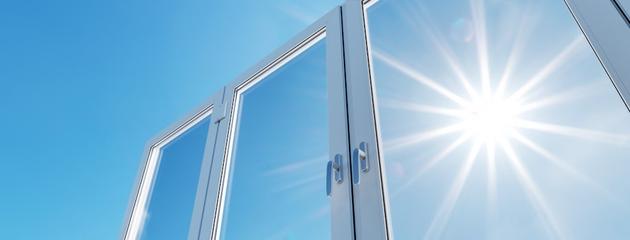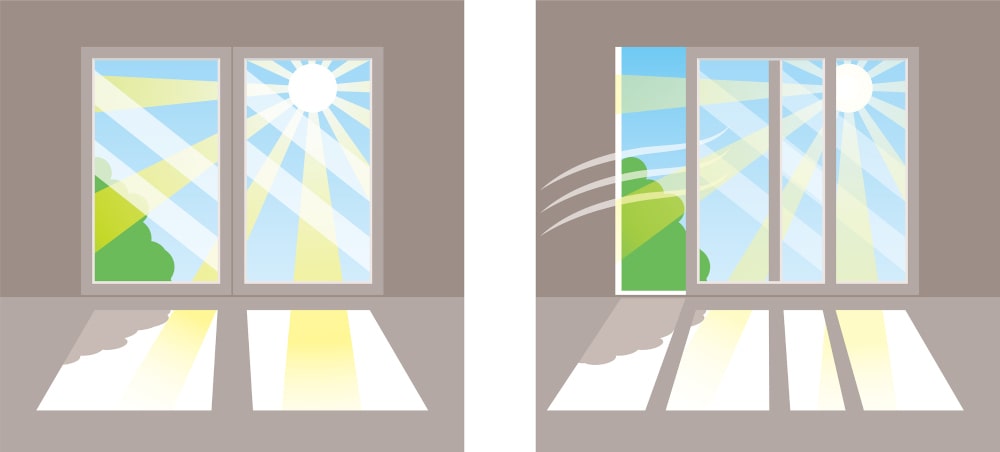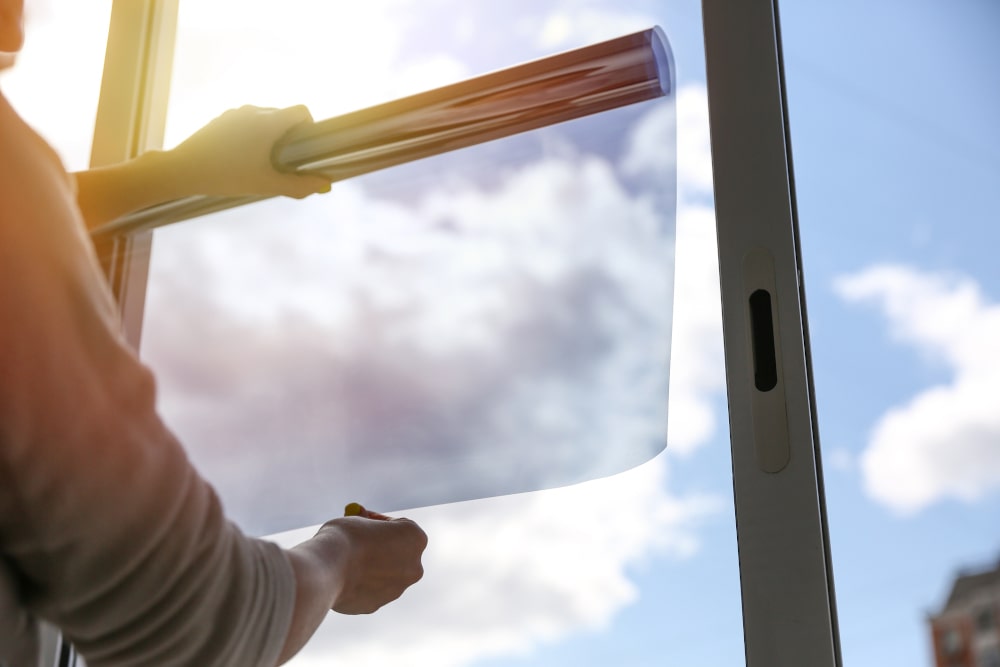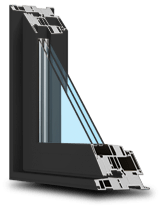The Importance of Choosing UV-Protectant Windows

Key Takeaways
- UV rays can penetrate indoor spaces through regular and even double-pane windows, causing damage to furniture, flooring, and human health, particularly through exposure to UVA radiation.
- UVA and UVB rays are the primary culprits: UVA fades materials and ages skin, while UVB contributes to surface-level skin damage.
- Low-E coatings, laminated glass, and smart window technologies offer advanced UV filtration, some blocking over 99% of harmful rays.
- Double and triple glazing alone aren’t sufficient for UV protection unless paired with UV-specific treatments, such as coatings or films.
- Certified UV-protectant windows, such as those with ENERGY STAR and NFRC ratings, ensure verified performance in both energy efficiency and UV reduction.
- Long-term benefits outweigh initial costs: homeowners save on energy bills, reduce furniture replacement costs, and may be eligible for insurance discounts.
- Common myths about indoor UV safety persist, including false beliefs that tinted glass or cloudy days eliminate exposure risk.
- Final recommendation: Invest in laminated or Low-E glass, verify certifications, and consider aftermarket window films when full replacements aren’t feasible.
What are UV rays, and how do they affect your home’s interior?
Most of us tend to think of UV rays as something we only need to worry about outside, but some can also make their way indoors. Ultraviolet light comes in three forms: UVA, UVB, and UVC. While UVC is blocked by the Earth’s atmosphere, UVA and UVB rays can pass through windows, contributing to the fading of furniture, damage to interiors, and even potential health risks over time.
Understanding UVA and UVB
- UVA rays have the longest wavelength and can penetrate deep into the skin and materials. They are the primary culprits behind fading in fabrics and wood.
- UVB rays are shorter in wavelength but more energetic. These are largely responsible for skin burns and surface-level damage.
You might think your interiors are protected, but up to 50% of UVA rays can penetrate standard glass, causing fading and wear to furniture and other surfaces over time.
Damage to Furniture and Flooring
UV exposure can cause significant deterioration to:
- Hardwood floors , leading to discoloration and drying
- Leather furniture , which may crack and fade
- Fabric upholstery , where dyes break down and become patchy
- Artwork and books are losing their vibrancy and becoming brittle
How do windows block UV rays — and do they really work?
The effectiveness of windows at blocking UV rays depends on the material composition, coatings, and glazing techniques used. Let's break down how each plays a role.
Window Coatings
Low-E (low emissivity) coatings are ultra-thin metal oxide layers applied to glass. They reflect infrared and UV radiation while allowing visible light to pass through. Depending on the type (soft coat vs. hard coat), Low-E coatings can block up to 99% of UV rays.
Double and Triple Glazing
- Double-glazed windows feature two panes of glass with a sealed air or gas layer, reducing thermal transfer and blocking a portion of UV rays.
- Triple-glazed windows feature an additional pane, enhancing insulation and UV protection.
While these windows don’t inherently block UV, they often come with UV-protective coatings.
Laminated Glass
Composed of two glass layers with a PVB (polyvinyl butyral) interlayer, laminated glass is recognized for its exceptional UV filtration, which often blocks over 99% of UVA and UVB rays.
"Laminated glass is a top choice for homes with valuable interiors or large south-facing windows," says Tony Wong . "It provides robust UV protection without compromising aesthetics."

What types of windows offer the best UV protection today?
Several modern options are available that provide exceptional UV defense while also contributing to energy efficiency.
Low-E Glass
Low-E glass remains a leading solution for UV filtration.
- Reflects up to 98-99% of UV radiation
- Improves thermal efficiency
- Comes in different grades for varying climates
Laminated Glass
As mentioned, laminated glass offers maximum UV protection and additional security benefits, including shatter resistance.
- Often used in high-end residential builds
- Pairs well with Low-E for double protection
Smart Tints and Electrochromic Glass
This next-gen solution adjusts tint levels based on the intensity of sunlight.
- Automatically dims during peak sun hours
- Blocks UV along with controlling visible light
- Ideal for smart homes and energy-conscious designs
Window Films
For those not ready for a complete window replacement, aftermarket films are an affordable add-on:
- UV-blocking capacity up to 99%, depending on the brand
- Some also reduce glare and heat
- Lifespan of 10-15 years with proper installation

Manufacturer Comparison Table
| Window Type | UV Protection | Energy Efficiency | Ideal Use |
|---|---|---|---|
| Low-E Double Glazed | High (98-99%) | High | Standard residential |
| Triple Glazed | Very High | Very High | Harsh climates |
| Laminated Glass | Very High | Medium | High-value interiors |
| Smart Tint Glass | High | Variable | Luxury/smart homes |
| Window Films | Medium-High | Medium | Retrofits and rentals |
Ultimately, the best option depends on location, budget, and usage needs .
Do UV rays go through regular glass or double-pane windows?
There's a common belief that staying indoors means staying protected from UV rays. While partially true, the type of glass in your windows determines just how much UV actually gets through.
Clear vs. Tinted vs. Treated Glass
- Clear single-pane glass offers little resistance, allowing up to 75% of UVA rays to pass through.
- Tinted glass provides slightly improved protection, depending on the type of dye and its thickness.
- Treated glass , such as Low-E or laminated, can block 95–99% of harmful UV radiation.
Glass Testing Results
A comparative lab test conducted by the National Glass Association found:
- Standard clear glass: 74% UVA penetration
- Double-pane clear glass: 59% UVA penetration
- Laminated glass: <1% UVA penetration
- Low-E coated double-pane glass: 2–5% UVA penetration
Why It Matters
Long-term exposure — even through double-pane windows — can still degrade materials and have adverse effects on the skin. If you're investing in high-end interiors or spending time near sunny windows, untreated glass is a weak point.
How to choose a certified UV-protectant window for your home
Not all windows are built equally, and certifications help separate the effective from the ineffective. Here's how to ensure your next installation truly protects.
ENERGY STAR and UV Ratings
- ENERGY STAR-certified windows must meet stringent UV transmittance limits
- Often combined with performance ratings for insulation and visible light
Check the label for:
- Solar Heat Gain Coefficient (SHGC) under 0.30 (indirect UV indicator)
- Visible Transmittance (VT) that balances light and protection
NFRC Certification
The National Fenestration Rating Council (NFRC) provides trusted ratings for window performance.
Look for:
- U-Factor (insulation)
- SHGC (solar gain, UV-related)
- VT (light transparency)
Manufacturer Guarantees
Quality manufacturers provide written guarantees of:
- UV blocking percentages (usually 95%–99%)
- Glass type and coating durability
- Lifespan warranties (20–30 years)
Certification Comparison Table
| Label/Agency | What It Measures | Importance of UV Protection |
|---|---|---|
| ENERGY STAR | SHGC, insulation | High — Ensures general solar filtering |
| NFRC | U-Factor, SHGC, VT | High — Third-party verified |
| Manufacturer Warranty | UV Block %, Glass Type | Essential — Shows practical durability |
Before making a choice, request product specification sheets and certification documents. Don’t rely solely on sales language.
"Certification means a window has been independently tested for energy efficiency and performance," says Helen Sin . "Look for the NFRC label, and read the warranty carefully — those details matter in the long run."
Are UV-protectant windows worth the investment?
Homeowners often hesitate at the higher upfront costs of UV-protective windows. But when you factor in long-term savings and home health, the math often works in your favour.
Long-Term Cost Savings
- Furniture longevity: Preventing UV fading extends the life of costly interior items.
- Energy efficiency: Low-E and laminated options reduce cooling costs by up to 30% annually, according to Natural Resources Canada.
- Reduced HVAC load: UV-filtering reduces solar heat gain, preserving your air conditioner.
Maintenance Reduction
- Less fading means fewer replacements or reupholstering.
- Reduced cracking and warping in wood and leather
- Windows with UV-blocking coatings often include scratch-resistant finishes, requiring less frequent cleaning or servicing.
Insurance and Property Value Benefits
- Some home insurance providers in Canada offer lower premiums for homes equipped with impact-resistant laminated glass , especially in regions prone to storms or break-ins.
- UV protection and energy efficiency also make homes more attractive to eco-conscious buyers , boosting resale value .
"The upfront cost may seem high," says Tony Wong , "but most homeowners recoup it within five to seven years through lower energy bills and replacement savings ."

What should you ask your installer about UV-blocking window options?
Choosing the right window is only half the battle. Proper installation ensures that your investment performs as promised.
Key Buyer Questions
- What UV protection rating does this window offer?
- Are the Low-E coatings soft or hard coats?
- Is the glass laminated or double-glazed?
- Does this product meet ENERGY STAR or NFRC certifications?
Signs of Good (and Bad) Installation
Good Installers Will:
- Show your label certifications
- Use backing tape and sealants rated for UV glass
- Provide a thorough cleanup and inspect the seal integrity
Red Flags:
- Rushing the job
- Unwilling to explain coatings or ratings
- No warranty paperwork provided on completion
Warranty and Coverage
Ask for a written warranty that clearly outlines:
- UV-block percentage guaranteed
- Lifespan of coating and glass.
- Conditions that void warranty (e.g., improper cleaning agents)
Installer Checklist
- Certified Low-E or laminated glass
- ENERGY STAR/NFRC label
- UV-block rating ≥ 95%
- Warranty paperwork in hand
- Post-install inspection offered
What are the most common myths about UV rays and windows?
Even well-informed homeowners fall prey to persistent myths about UV exposure indoors. Let’s bust some of the most common ones.
Myth 1: Cloudy Days Mean No UV Exposure
Reality: UVA rays are not blocked by clouds. Even on overcast days, over 80% of UV rays still reach the ground, according to the WHO.
Myth 2: Tinted Glass Blocks All UV Rays
Reality: Basic window tinting may reduce brightness and glare, but often does not filter out enough UVA. Without added coatings or lamination, UV levels indoors can remain dangerously high.
Myth 3: If You’re Indoors, You’re Safe
Reality: Standard clear glass allows up to 75% of UVA rays through. Without UV-filtering treatments, skin damage and interior fading still occur.
Myth 4: Only South-Facing Windows Need Protection
Reality: UV rays reflect off surfaces like snow, water, or nearby glass buildings. Even north-facing rooms can suffer long-term exposure.
How to protect your home from UV damage with the right windows
Protecting your home from UV damage isn’t just about comfort — it’s about safeguarding your investment, health, and peace of mind.
Summary of Benefits
- Reduced fading and longer-lasting furniture
- Improved health outcomes due to decreased UVA exposure
- Lower utility costs via energy-efficient window designs
Final Recommendations
- Opt for laminated or Low-E glass, preferably both.
- Ensure your installer is certified and transparent about materials
- Ask for documentation: certifications, UV ratings, warranties
- Consider window films for retrofits or budget-friendly solutions
Summary Chart
| Solution Type | Protection | Lifespan | Ideal Use |
| Low-E Glass | High | 20–30 years | New builds & upgrades |
| Laminated Glass | Very High | 30+ years | High-sun or valuables |
| Smart Tint Glass | High | 10–20 years | Smart & luxury homes |
| Window Films | Medium-High | 10–15 years | Retrofits & renters |
1000’s of Colours & Textured Finishes
Transform your home from ordinary to extraordinary with our new coloured and non-glare textured finishes. Available in a wide array of colours as well as custom matched colours for your very own personalized design.
Our Most Popular Replacement Window Colours:










